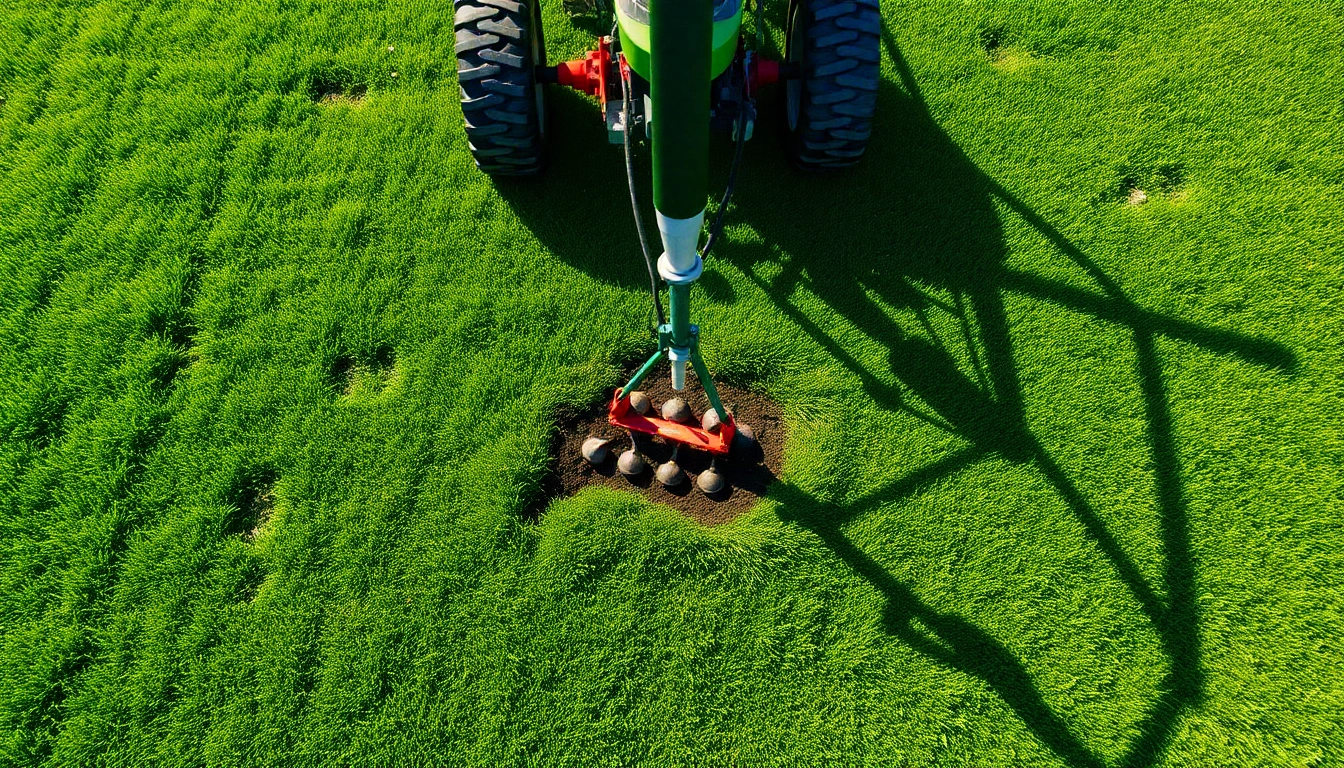Understanding Core Aeration
What is Core Aeration?
Core aeration, often referred to as plug aeration, is a vital lawn care process that entails the removal of small cylindrical plugs of soil from the lawn. This technique allows for improved air circulation, water penetration, and nutrient absorption in the soil. Core aeration is particularly useful in combating soil compaction, which can impede root growth and decrease the overall health of your lawn. Essentially, this process enhances the growing conditions for grass and other plants, leading to a lush and vibrant green space.
If you’re looking to enhance your lawn’s health, understanding core aeration is essential. This process isn’t just a method for visual improvement; it’s a necessary practice for maintaining a thriving landscape.
The Science Behind Aeration
The science of core aeration is grounded in the principles of soil biology and plant physiology. When soil becomes compacted – due to foot traffic, heavy equipment, or natural causes – it restricts the movement of air, water, and nutrients, which are essential for plant growth. Core aeration works by extracting plugs of soil, generally ranging from ½ to ¾ of an inch in diameter, creating holes about 2 to 4 inches apart. This process opens up the surface of the soil, allowing for better oxygen exchange and improving the soil’s ability to retain moisture.
Furthermore, the holes created by aeration give roots more space to grow, promoting deeper root systems that enhance drought resistance and overall lawn vitality. As the soil plugs decompose on the surface, they also return valuable organic matter to the soil, enriching it naturally.
Benefits of Core Aeration for Your Lawn
Core aeration offers numerous benefits that contribute to healthier and more resilient lawns:
- Enhances Soil Structure: By breaking up compacted soil, aeration improves the soil’s physical structure, leading to better drainage and moisture retention.
- Improves Nutrient Absorption: With increased air circulation and soil permeability, nutrients from fertilizers and organic matter are more effectively absorbed by the grass roots.
- Increases Root Growth: Deeper and healthier roots lead to a more drought-resistant lawn that can withstand various environmental stressors.
- Reduces Thatch Buildup: Core aeration helps break down thatch, the layer of dead grass and roots that can suffocate the lawn if it gets too thick.
- Promotes Microbial Activity: The process encourages increased microbial activity in the soil, leading to a healthier ecosystem that supports grass growth.
When to Perform Core Aeration
Best Seasons for Aeration
The timing of core aeration is crucial for maximizing its effectiveness. Ideal aeration periods vary depending on whether you have cool-season or warm-season grasses:
- Cool-Season Grasses: For grasses such as Kentucky bluegrass and fescue, early spring or early fall is the best time. These seasons align with the natural growth cycle of the grass, allowing it to recover quickly after aeration.
- Warm-Season Grasses: Lawns with Bermuda or Zoysia grass should be aerated in late spring through early summer when the grass is actively growing.
Signs Your Lawn Needs Aeration
Recognizing when your lawn requires aeration is essential. Here are some telltale signs:
- Soil Compaction: If your lawn is often walked on or vehicles drive over it regularly, it is likely compacted.
- Poor Drainage: Puddling after rain or irrigation can indicate compaction.
- Thatch Buildup: A thatch layer thicker than ½ inch can inhibit growth and may necessitate aeration.
- Worn and Thin Areas: Spots that look sparse or unhealthy can benefit from aeration to encourage lush growth.
Frequency of Core Aeration for Different Lawn Types
The frequency of core aeration largely depends on the type of lawn you have and how much traffic it endures:
- High-Traffic Areas: Lawns that experience heavy foot traffic or have clay soils may require aeration every year.
- Moderate Use: Aerating every 2 to 3 years is adequate for average lawns.
- Low-Traffic Areas: For lawns that receive little use, breaching every 3 to 4 years is often sufficient.
How to Perform Core Aeration
Preparing Your Lawn for Aeration
Before you begin the aeration process, proper preparation is essential:
- Check Soil Moisture: Opt for a day when the soil is moderately moist but not overly wet, as this will make it easier for the aerator to remove plugs.
- Mow Your Lawn: Mow the grass to about 2 to 3 inches high to ensure that the aerator reaches the soil effectively.
- Remove Debris: Clear the area of leaves, sticks, and any other debris that could hinder the aeration process.
Step-by-Step Aeration Process
Follow these steps for an effective aeration process:
- Choose Your Aeration Method: Decide whether to rent a machine or hire a professional service. Manual aerators are suitable for smaller lawns, whereas powered aerators are more efficient for larger spaces.
- Pass the Aerator: Walk at a steady pace with the aerator covering a variety of passes. Overlap the passes to ensure thorough coverage.
- Leave Soil Plugs: After core aeration, leave the soil plugs on the lawn surface. They will decompose, enriching the turf.
Post-Aeration Care Tips
After aerating, take care to implement the following tips for optimal recovery:
- Water Generously: Water your lawn immediately after aeration to help promote recovery and optimize nutrient uptake.
- Apply Fertilizer: A balanced fertilizer can capitalize on the aeration process, aiding healthier growth.
- Overseed When Necessary: Consider overseeding after aeration to enhance thickening and rejuvenation of your lawn.
Common Mistakes in Lawn Aeration
Over-Aerating Your Lawn
One common mistake is over-aerating. While aeration is beneficial, too frequent aeration can lead to too many holes and weaken the grass. Ensure you follow recommended guidelines based on your lawn type and condition.
Ignoring Soil Conditions
Another mistake is neglecting to assess soil conditions before aerating. If your soil is excessively dry or overly saturated, the aerating process may not yield the desired results. Always consider soil moisture levels before commencement.
Neglecting Aftercare
Finally, neglecting the aftercare of your lawn can diminish the benefits of aeration. Follow up with adequate watering, fertilization, and overseeding as required to ensure your lawn thrives post-aeration.
Professional Core Aeration Services
Choosing the Right Service Provider
When selecting a professional aeration service, consider the following:
- Experience and Qualifications: Look for companies with a solid reputation and certified professionals.
- Client Reviews: Check reviews and testimonials from previous clients to gauge service satisfaction.
- Equipment Used: Ensure that the service provider uses modern, well-maintained aeration equipment.
- Cost: Get multiple estimates, but don’t choose solely based on price. Quality is paramount.
What to Expect from Professionals
When hiring professionals, you should expect an assessment of your lawn’s specific needs, a detailed plan for aeration, and thorough execution with care taken to leave your lawn in good shape. Professionals typically follow the best practices discussed earlier to ensure your lawn becomes healthier and more vibrant.
Cost Considerations for Core Aeration
The cost of core aeration can vary based on several factors, including:
- Lawn Size: Larger lawns will naturally be more expensive to aerate.
- Regional Considerations: Prices can vary significantly depending on location and the cost of living in your area.
- Service Packages: Some companies offer package deals that include other lawn services, which can provide better overall value.
As a rough estimate, the cost of core aeration typically ranges from $50 to $200 based on these variables.



